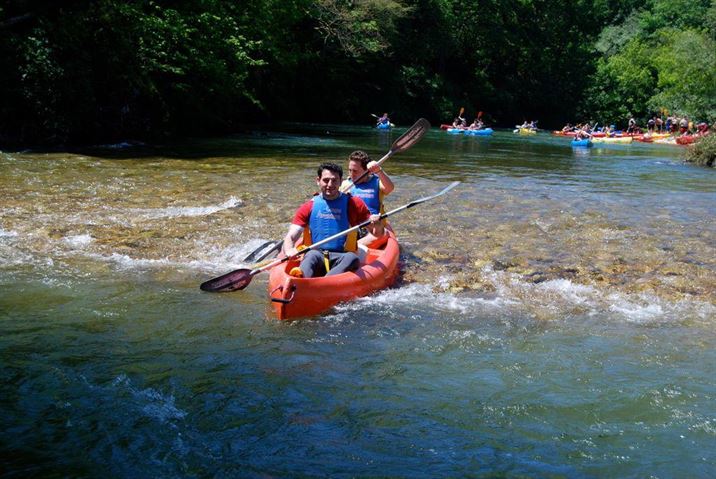Have you never ridden in a canoe? At Cangas Aventura, we give you all the information you need to get into this exciting sport while you embark on one of the most impressive and unforgettable canoe trips in the country: the Sella Descent.
Rowing or paddling in a canoe is a simple activity accessible to everyone with minimal knowledge. And that’s what we’re here for! In our activity, we give you all the necessary instructions to go downstream safely so that you only have to worry about enjoying yourself. You’ll see how operating a canoe is a very simple task for anyone following a few simple tips. Previous experience doesn’t matter for your Sella Descent to be a complete success. You’ll only have to follow the instructions that our monitors will give you at the beginning of the activity.
Additionally, to make the descent, you’ll have, of course, a canoe, a double-bladed paddle per person, a life jacket, a waterproof container to keep your things dry, and a wetsuit, booties, and raincoat in case the weather requires it. Once you have all the equipment and before entering the Sella, you’ll receive a brief and enjoyable training that will be more than enough for you to venture on your own on the beautiful route of the Descent. Among other things, you’ll receive instructions on how to make paddle movements, the role of each person in double or triple canoes, the correct position of arms and hands… And much more. Want a preview? Keep reading!
How to Start Paddling in a Canoe?
If it’s your first time holding a double-bladed paddle, it’s normal to have doubts about how to hold and handle it. It’s very simple: hold the handle with both hands, placing your knuckles upwards and separating them approximately at shoulder width. Once you’re holding the paddle correctly, it’s time to start moving it. First, make sure you’re holding it so that the concave side of the blades is facing you. Without gripping the handle too tightly to avoid hurting yourself or getting more tired than necessary, place your elbows bent at a 90° angle and use your torso to paddle.
“What do you mean by torso?” you might think. Indeed, you should focus your attention on your torso and rely on it to gain strength in each stroke by turning it from side to side. When you start paddling, keep in mind that you should exert force with the arm opposite to the blade that enters the water. That is, if you first put the left blade of the paddle into the river, the left arm should be responsible for inserting it and serving as a support point, but it should be the right arm with which you make the force to paddle.
Now you can start moving forward with your canoe: Insert the paddle into the water on one side of it, as far forward and close as possible, and slide it gently backward to then take it out of the water and repeat the same movement on the other side of the boat (and with the other blade of the paddle).
The Role of Each Canoe Crew Member
It’s also important to know, in case you’re doing the activity in a two-seater canoe, the role each person plays in handling the canoe. The person sitting in the back will be in charge of steering, while the one in front should set the pace. Since the latter can’t see how the person behind them is paddling, it should be the person occupying the back seat of the canoe who adapts to their speed and consistency of paddling, not the other way around.
The helmsman or person located at the stern of the canoe will be in charge of steering the boat along the Sella’s path. The idea is simple: to turn to one side, they should insert the paddle blade on the opposite side to which they want to turn. Want to turn right? Put the paddle in the water on the left side of the canoe. Want to turn left? Do the opposite movement.
Also, if you want to stop the canoe, both crew members should reduce their paddling speed and, if necessary to stop quickly, perform backward strokes. This means inserting the paddle at a point behind the canoe and moving it forward. This technique, as our instructors will explain at the beginning of the activity, can be even more effective if the paddle is kept at a high angle, that is, as vertical as possible. If it is placed horizontally while performing this technique, it is likely that instead of stopping the canoe, it will spin on itself.
Have you grasped the essentials? Don’t worry if you still have questions, everything will seem much easier once you get in the canoe. Book the Sella River Descent activity with us now and trust highly experienced professionals for the organization of an incomparable activity that you will always remember.

